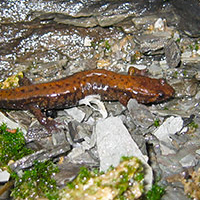Allegheny Mountain Dusky Salamander
Scientific name: Desmognathus ochrophaeus

Photo credit: Rob Tervo
Status
Endangered
“Endangered” means the species lives in the wild in Ontario but is facing imminent extinction or extirpation.
Date added to the Species at Risk in Ontario List
The Allegheny Mountain Dusky Salamander was already assessed as at-risk when the Endangered Species Act, 2007 took effect in 2008.
Read the most recent assessment report (PDF).
What it looks like
The Allegheny Mountain Dusky Salamander is a small, slender salamander that reaches about seven to 10 cm in total length. The adults usually have a light stripe down their entire back extending from the head to the tail.
The stripe ranges in colour from yellow to orange to brown depending on age and sex, and often includes a row of chevron-shaped dark spots down the middle.
The sides are speckled and the belly ranges in colour from dark brown to black.
Where it lives
Allegheny Mountain Dusky Salamanders are found most often in or near forested small streams, springs, or seeps (areas where water in the ground oozes to the surface to form a pool).
They typically nest in underground cavities close to seeps, or in shallow depressions in moist soil beneath logs, stones, moss, leaf litter or stumps.
They are usually absent from larger streams where predatory fish occur. Other predators include watersnakes and birds.
Where it’s been found in Ontario
The Allegheny Mountain Dusky Salamander is widely distributed in eastern North America. In Ontario, it occurs along two streams within the Niagara Gorge.
What threatens it
The Niagara area of Ontario has undergone significant development since European settlement, resulting in a loss of habitat quantity and quality.
Activities that affect the quality and quantity of groundwater can result in a loss of high-quality habitat that is essential to the survival of the Allegheny Mountain Dusky Salamander. These threats can be caused by:
- dams and water management
- habitat modification by the invasive Common Reed (Phragmites australis)
- sources of pollution such as industrial effluents (runoff)
In addition, uncontrolled stormwater runoff has caused slope instabilities in adjacent areas, leaving these salamanders vulnerable to rock falls and mudslides.
Excessive human disturbance, such as trampling, is also a threat to this species.
Action we are taking
This species and its habitat are protected under Ontario’s Endangered Species Act, 2007 (ESA).
The ESA also requires us to prepare recovery guidance for endangered species such as Allegheny Mountain Dusky Salamander to guide recovery efforts for the species in Ontario. All species listed on the Species at Risk in Ontario List may be eligible for consideration for government funding through the Species at Risk Stewardship Program.
Recovery strategy
A recovery strategy advises the ministry on ways to ensure healthy numbers of the species return to Ontario.
Executive summary (January 11, 2013)
Full document (January 11, 2013)
Government response statement
A government response statement outlines the actions the government intends to take or support to help recover the species.
Read the government response statement (October 11, 2013)
Five-year review of progress
A five-year review of progress made toward protecting and recovering a species is required no later than five years after the government response statement for that species is published.
Read the report on progress towards the protection and recovery of 17 species at risk, including the Allegheny Mountain Dusky Salamander and Northern Dusky Salamander (2018).
Habitat protection
General habitat protection - June 30, 2013
What you can do
Report a Sighting
Submit your observations of species at risk to the Natural Heritage Information Centre (NHIC), which is Ontario’s conservation data centre. Join the centre’s Rare Species of Ontario project in iNaturalist, an online plant and animal identification app, to quickly and easily submit your observations.
Volunteer
Volunteer with your local nature club or provincial park to participate in surveys or stewardship work focused on species at risk.
Be a good steward
- Private landowners have a very important role to play in species recovery. If you find species at risk on your land, you may be eligible for stewardship programs that support the protection and recovery of species at risk and their habitats, such as the Species at Risk Stewardship Program.
- Invasive species seriously threaten many of Ontario’s species at risk. To learn what you can do to help reduce the threat of invasive species, visit:
- As with all wildlife, be respectful and observe from a distance. Please do not try to catch wild salamanders. Bug repellent and oils on human hands may damage the delicate skin of these little amphibians.
- Never buy salamanders that have been caught in the wild and never buy a native species of any kind that is being sold as a pet.
- Visit the Herpetofaunal Atlas website to learn more about Ontario’s reptiles and amphibians and the data collected on them.
Report illegal activity
Report any illegal activity related to plants and wildlife to
Quick facts
- The Allegheny Mountain Dusky Salamander was only recently discovered in Ontario in 2004. Prior to that, the Canadian population was only known to occur in Quebec.
- These salamanders overwinter below the frost line in seeps and underground retreats where the ground temperature is fairly constant.
- Mating and egg-laying take place in the fall and spring and involve quite an elaborate courtship, including a characteristic ‘tail-straddle’ walk.
- When seized by a predator, the Allegheny Mountain Dusky Salamander has the ability to self-amputate its tail which continues to twitch, acting as an excellent diversion while the salamander escapes. A new tail soon replaces the old one.